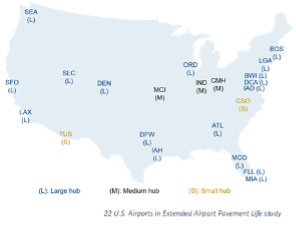The longer an airfield pavement remains in service, without disruption, the greater the value for taxpayers and travelers. Fewer rehabilitation projects at busy airports results in lower capital costs, reduced delays, and less downtime for pavement reconstruction. This equates to cost savings over the life of the pavement.
Airport users and airlines also see benefits due to fewer construction-related delays. Longer pavement life also means fewer negative environmental impacts. To realize these gains, the FAA is developing methodologies to extend the service life of our nation’s airfield pavements at large-hub airports from 20 to as much as 40 years.
The outcome of this research program will be an improved pavement design method that incorporates long-term performance prediction models.
What is pavement life?
Current pavement design procedures are based on a 20-year structural life. How many times can aircraft pass over the pavement structure before it fails by fatigue? This definition assumes that pavement functional life is the same as structural life, which it turns out, is an acceptable model for 20-year pavement design. But to support extended life – much more than 20 years – pavement design must go beyond traditional analysis to consider how non-structural, functional failures such as roughness, rutting, or surface cracking drive the decision to rebuild pavements.
Major rehabilitation triggers are profile roughness (smooth ride), foreign object debris (FOD) risk, and low friction (skid resistance). FAA’s working definition for extended pavement life begins with Serviceability Level (SL), a function of a pavement’s ability to prevent roughness and FOD and provide adequate skid resistance. Intervention is required when either total SL, or partial SL, based on one or more triggers, falls below a minimum acceptable level. Pavement life ends when reconstruction costs are lower than other interventions capable of raising the SL above its minimum acceptable level for 10 years.
Airport Technology Research & Development Branch Research
 The extension of airport pavement life encompasses all airport pavement research and development areas (design, materials, and evaluation), as well as various airport safety areas. Since 2011, the FAA has collected data related to extending airport pavement life from 28 runways at 22 U. S. airports. These data include 17 of the 30 airports designated large hubs in 2017, as well as three medium-hub and two small-hub airports.
The extension of airport pavement life encompasses all airport pavement research and development areas (design, materials, and evaluation), as well as various airport safety areas. Since 2011, the FAA has collected data related to extending airport pavement life from 28 runways at 22 U. S. airports. These data include 17 of the 30 airports designated large hubs in 2017, as well as three medium-hub and two small-hub airports.
The FAA is using real-world data to identify key performance trends and develop improved pavement life prediction models—models which are expected to form a comprehensive, and lasting, foundation for airfield pavements with cost-effective service lives.
As part of this study, FAA is collecting data to include:
- Historical traffic
- Friction records
- Pavement Condition Index (PCI) distress surveys
- Heavy Weight Deflectometer (HWD) testing
- Profile, groove, and texture measurements from 12 of 28 runways
- Core samples and soil borings for characterization by FAA’s NextGen Materials Testing Laboratory
Under this project, FAA is developing an extensive database of construction and long-term performance data covering large- and medium-hub airfield runways in the United States. The Extended Airport Pavement Life (EAPL) database was created based on the FAA PAVEAIR Airport Pavement Management System platform. The EAPL data analysis will focus on developing new design models and procedures that will apply to both flexible and rigid pavements for extended design periods up to 40 years.
LEARN MORE